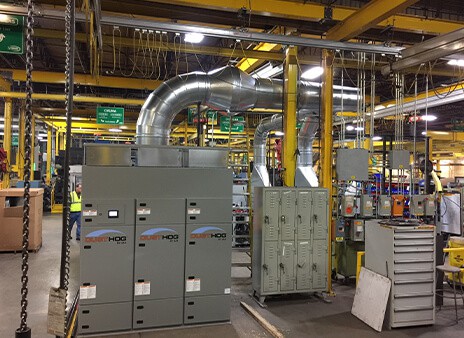Author: Tony Pfenning
A well-engineered dust collection system considers what Dynacom calls the “5 Cs of Dust Collection.” Each is equally important and must receive adequate consideration:
- Capture: The type of hood and capture device
- Convey: The size and type of duct
- Collect: The dust collection or air filtration technology
- Clean: The maintenance of the system
- Combustibility: The explosiveness or flammability of the material
Various technologies can collect the contaminants for each type of process and contaminant. For example:
- Electrostatic precipitators are ideally suited for collection of submicron contaminants
- Media filtration units are ideally suited for the collection of dust and mists in low concentrations
- Dust collection equipment is ideally suited for a wide variety of contaminants
- Cartridge units
- Cyclone collectors
- Oil mist collectors
1. Capture
The goal of a source capture system is to contain the dust/smoke before entering the ambient air.
The first step in designing a source capture system is to determine the most effective type of hood design and then decide where to place the hood relative to the location of the contaminant source. Essential things to keep in mind are:
- Thermal air currents
- How the machinery moves, for example, grinding wheels, belt conveyors, and arc-cutting equipment
- The containment and handling of the material, for example, dumped, filling a container, etc.
- Movement of the operator
- Natural room air currents and those changed due to heating or air conditioning
However, the same basic principle applies in all instances: a hood placed closer to the source will result in a lower air volume requirement.
2. Convey
Often, companies overlook the dust collector or air filtration system’s duct system. We can think of the duct system as the arteries carrying dust from the source to the collector. If not appropriately sized, dust, mist, or smoke will settle, resulting in duct blockage, fire hazards, combustible applications, and explosion hazards.
It’s essential to carefully consider and engineer the duct design (branch entries and elbows) to minimize resistance to the air stream. The system’s design will directly impact the fan’s horsepower.
There are many different types of ducts, such as:
- Nordfab Clamp Together Duct: Its simplicity and ease of installation make it one of the most common ducts. Plus, it provides flexibility for future changes.
- Spiral pipe: An economical duct for light dust collection projects. We recommend avoiding this for oily applications as it will leak.
- Welded duct with flanged ends: Commonly used on heavier, abrasive dust applications. While the most expensive, it is also the most durable duct system.
3. Collect
Many dust collection and air filtration technologies are available today, including baghouses, reverse pulse cartridge-style, cyclones, ESPs, media systems, centrifugal mist collectors, and wet collectors. When selecting a technology, we consider:
- The type of contaminants (and all the characteristics, such as particle size)
- The loading (how much of the contaminant gets generated)
- The desired/necessary filtration requirements
Each collector has various options, such as silencers, cleaning controls, dust disposal, and many more to consider.
Experience plays a significant role in determining which technology best suits a given application. This experience is available to you through our manufacturers and personnel at Dynacom, Inc.
Standard parameters our team utilizes to determine which technology is best include the following:
- Loading: How much gets generated in a given time (cubic feet in a day)?
- Hours of operation: How many shifts are they operating?
- Characteristics of the dust: What is the dust? Is it abrasive? Is it sticky? Is it granular or fibrous?
- The process: What is their process/operation (i.e., dry grinding, welding, plasma cutting, wet grinding, machining, etc.)
- Temperature of the airstream: Most often, the temperature will be close to ambient temperatures and is not an issue.
4. Clean
How the collector is maintained is critical to any system. There is no such thing as a maintenance-free air filtration or dust collection system. However, there are ways to automate the cleaning, which are considered based on the end user’s requirements.
The maintenance of any system is a crucial factor. If the system is not maintained, it will not function properly. Electrostatic precipitators require manual water wash cleaning. Media systems require filter change-outs and potentially expensive replacement filters. Cartridge-type dust collectors reverse pulse the filters to keep them clean continuously and online during operation.
5. Combustibility
The generator of any dust must determine whether it is combustible. In many instances, this may require the producer of the dust or contaminants to have the material tested to determine the Kst value (how combustible the dust is). Per the OSHA standards set by the NFPA, anything over a Kst value of zero (0) should have proper explosion venting and all other applicable controls.
The client is responsible for determining whether these controls are necessary. When discussing “dust collection systems,” ALWAYS determine if the dust is combustible. If the dust is combustible, this can significantly impact the design and cost of the system. Controls and limitations for dust collection systems collecting explosive (different than flammable) dust can include, but are NOT limited to, the following:
- Explosion venting on the dust collector
- Explosion suppression systems
- Isolation gates (on the inlet and possibly on the outlet duct)
- Fire suppression systems
- Location of the collector (may need to be located outside and follow specific parameters relative to personnel traffic, such as parking lots, exit doors, etc.)
- Duct design and velocities (i.e., duct systems collecting explosive dust should NOT have slide gates at branches and typically have minimum duct velocities they must maintain.
- The ability to return the exhaust air within the building.
The Dynacom Difference
As you can see, there are many steps to designing a dust collection system. The key is to ask the right questions to understand the problem and recommend the best solution.
At Dynacom, our industrial air filtration specialists work with customers to develop a complete understanding of the problem and the resources available to help address the issue and recommend the best solution. Contact our team today to discover how we can utilize the “5 Cs of Dust Collection” in your application!
Key blog takeaways
- The "5 Cs of Dust Collection" are equally important: Capture, Convey, Collect, Clean, and Combustibility
- The maintaining of the collector is critical to any system. There is no such thing as a maintenance-free air filtration or dust collection system.
- Often, companies overlook the dust collector or air filtration system's duct system. The duct system is like arteries carrying dust from the source to the collector.

Subscribe to blog updates
"*" indicates required fields
Contact us for assistance
If you have a question, need information or would just like to chat with us, feel free to drop us a line.
If you're in need of technical product assistance on existing equipment, please contact us by phone as you will get a response more quickly: (440) 543-1900. Thank you.
"*" indicates required fields
